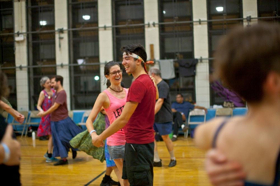Learn to Waltz for $5 Featuring Live Music

Country Dance*New York (CD*NY) is presenting A Day of Waltz & Contra Dance on Saturday, January 13, 2018 with live and lively music by three stellar musicians: Larry Unger, Naomi Morse, and Marco Brehm. No previous experience is required and it is not necessary to come with a partner. All dances will be taught.
Three waltz sessions are being offered followed by an evening contra dance:
3:00pm - 4:00pm Advanced waltz workshop
4:00pm - 5:00pm Beginner's waltz workshop
5:15pm - 6:45pm Open waltzing for all to live music
7:30pm - 8:00pm Contra dance introductory workshop
8:00pm - 10:45pm Contra dance for all to live music
The highly regarded caller and teacher Gaye Fifer will teach the afternoon waltz workshops and in the evening, walk everyone through the patterns of each contra dance making the dancing a pleasure for all. All the January 28 workshops and dances will be held at the Church of the Village, 201 West 13th Street, New York City.
Admission: Waltz workshops: $5 for one or both workshops; Open waltzing: $11 general public, $9 for students with ID or CDNY members; Workshops plus open waltzing: $15 general public, $12 students or CDNY members; Contra dance (including contra introductory workshop): $15 general public, $12 students or CDNY members.
The outstanding musicians performing on January 13 are among the top dance musicians in the U.S. and include Larry Unger, guitar and banjo; Naomi Morse, fiddle; and Marco Brehm, bass.
Gaye Fifer is an accomplished contra dance caller and waltz instructor from Pittsburgh, PA. An active dancer herself, she understands the subtleties of making contras and waltzes particularly satisfying for dancers. Her instructions are clear and concise, and her easy smile and delightful sense of humor help to make dances she presides over fun for all attendees.
The waltz is a smooth, progressive ballroom and folk dance, in triple time, performed primarily in closed position. Shocking many when it was first introduced, the waltz became fashionable in Vienna around the 1780s, spreading to many other countries in the following years. It became popular in Britain during the Regency period and according to the Oxford English Dictionary was considered "riotous and indecent" as late as 1825. Over time, new types of waltz have developed, including many folk and several ballroom dances. The contra waltz (freeform waltz) included in most contra dance evenings, uses both open and closed positions, and incorporates moves from other dances such as swing, modern jive, and salsa. Basically, the dancers progress around the room with a waltz step, but with no constraints on what moves they can use. Today, waltzes are extremely popular with dancers of all ages.
Contra dancing is having a renaissance around the country, thanks to a thriving youth scene; lively, uplifting acoustic music; and joyful, fast-paced, aerobic dancing. Contra dancing started in New England in the 1700s, but the modern version is a far cry from the Virginia Reel-type dancing done in schools years ago. The current dancing is done in lines of dancers facing their partners and moving briskly in patterns to live music, dancing with a partner, and also with others they meet in the course of a dance.
Further information can be found at www.cdny.org or by calling 212.459.4080.
Attendees are asked to bring a separate pair of clean, soft-bottomed shoes for dancing.

Videos

